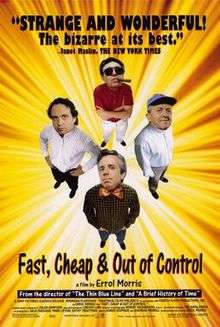Fast, Cheap & Out of Control
Fast, Cheap & Out of Control is a 1997 film by documentary filmmaker Errol Morris. It profiles four subjects with extraordinary careers: Dave Hoover, a lion tamer; George Mendonça, a topiary gardener at Green Animals Topiary Garden in Portsmouth, Rhode Island, including giraffes made out of boxwood; Ray Mendez, a hairless mole-rats expert; and Rodney Brooks, an M.I.T. scientist who has designed bug-like robots.
| Fast, Cheap & Out of Control | |
|---|---|
 Theatrical release poster | |
| Directed by | Errol Morris |
| Produced by | Errol Morris |
| Starring |
|
| Music by | Caleb Sampson |
| Cinematography | Robert Richardson |
| Edited by | Shondra Merrill Karen Schmeer |
| Distributed by | Sony Pictures Classics |
Release date |
|
Running time | 82 minutes |
| Country | United States |
| Language | English |
| Box office | $878,960 (USA) |
Each interview acts as the guiding narration of the film. The further the film goes on, the more intertwined each story becomes. The soundbites deriving from each man discusses material like their personal lives, what led each man to their profession, and what challenges they face in their work.
Style
In Fast, Cheap & Out of Control, Morris uses a camera technique he invented which allows the interview subject to maintain eye contact with the interviewer, while also looking directly into the camera, seemingly making eye contact with the audience. The invention is called the Interrotron which Morris uses in a number of his other films. This invention, according to Morris, alters interviews in the sense that, "no longer is it the interviewer, the camera, and the subject; with the Interrotron, the conversation is between the camera/interviewer and the subject."[1] Morris uses the four main subjects to narrate the film while displaying more artistic freedom through visual mechanisms. The cinematographer, Robert Richardson, uses many of the same camera techniques he used in his other films, JFK and Natural Born Killers. In addition to 35 mm cameras, he also uses Super 8 mm film. Some footage was even transferred to video and then filmed again being played "off a low-resolution television set."[2]
The film also uses footage from other sources, such as movie clips, documentary footage, and cartoons. Hoover's idol Clyde Beatty appears from portions of his film Darkest Africa and a malicious robot appears in scenes from Zombies of the Stratosphere. After using the first moments in the film to establish his characters one by one, with film clips that correspond to each subject, Morris then begins to mix footage relating to one subject with the narration of another, in order to establish more direct themes each subject shares.
Background
Gathering a multitude of noticeably different interview subjects was centered around the initial intention of creating a profile based film with no clear relation between its subjects. This moved beyond the idea of Morris' previous films which related interview subjects by events, like Gates of Heaven and The Thin Blue Line, or place of residency, like Vernon, Florida.[3]
The title of the film is a play on the old engineer's adage that out of "fast," "cheap," and "reliable," you can only produce an end consumer product that is two of those three (the classic example is a car). Rodney Brooks, the robot scientist from MIT, wrote a paper in which he speculates that it might be more effective to send one hundred one-kilogram robots into space, instead of a single hundred-kilogram robot, replacing the need for reliability with chance and sheer numbers, as systems in nature have learned to do. The advantage would be that if a single robot malfunctioned or got destroyed, there would still be plenty of other working robots to do the exploring. The paper was fully titled "Fast, Cheap and Out of Control: A Robot Invasion of the Solar System",[4] and published in the Journal of the British Interplanetary Society in 1989.
Soundtrack
The film's musical score is by composer Caleb Sampson, and is performed by the Alloy Orchestra. It is characterized as circus-like, sometimes frenzied or haunting, and features percussion (particularly mallets and xylophones) to give it a metallic, technological or futuristic flavor.
The film is available on VHS, DVD; the soundtrack by Caleb Sampson is available on CD.
References
- Silverman, Jason. "Fast, Cheap & Out of Control Interview With Filmmaker Errol Morris". The Austin Chronicle. Retrieved 1 May 2020.
- Resha, David (2015). The Cinema of Errol Morris. Middletown, Connecticut: Wesleyan University Press. p. 136. ISBN 978-0-8195-7534-0.
- Resha, David (2015). The Cinema of Errol Morris. Middletown, Connecticut: Wesleyan University Press. pp. 131–153. ISBN 978-0-8195-7534-0.
- "Fast, Cheap and Out of Control: A Robot Invasion of the Solar System"
External links
| Wikiquote has quotations related to: Fast, Cheap & Out of Control |
- Fast, Cheap & Out of Control on IMDb
- Fast, Cheap & Out of Control at AllMovie
- Fast, Cheap & Out of Control at Box Office Mojo
- Fast, Cheap & Out of Control at Rotten Tomatoes
- Fast, Cheap & Out of Control at Sony Pictures Entertainment